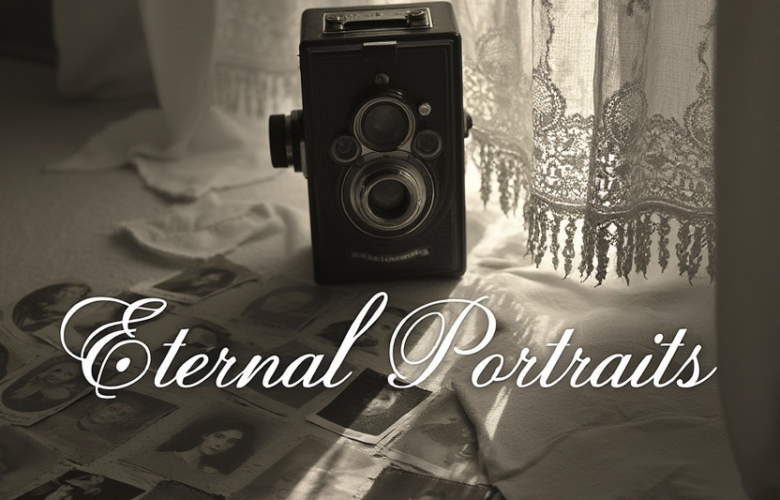In the shadows of history, there exists a realm where the living and the dead meet through the lens of a camera. ‘Eternal Portraits: A History of Post-Mortem Photography’ delves into the fascinating practice of capturing the deceased in strikingly poignant images, reflecting cultural attitudes toward death and mourning across different eras. Through gripping true stories and meticulous research, this book unveils a forgotten aspect of our past, exploring the intimate, often haunting, connection between life, death, and memory.
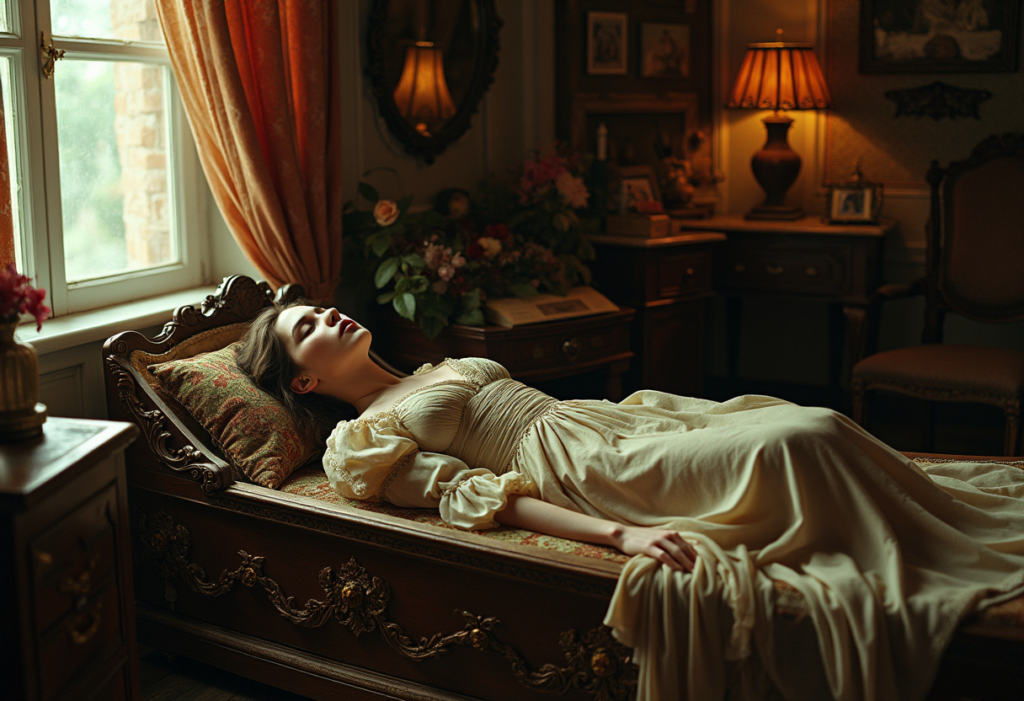
In the mid-19th century, a burgeoning interest in capturing moments and memories through the advent of photography intersected poignantly with the omnipresence of death in Victorian society. Health ailments that are now treatable were commonplace killers, and the average person was all too familiar with the specter of mortality. It was in this context that post-mortem photography emerged, offering the bereaved a tangible, visual connection to their departed loved ones. Each photograph served as a lasting memento, often cherished more dearly than any living portrait could be.
The technological advancements of this era played a crucial role in the inception of post-mortem photography. The invention of the daguerreotype made it possible for the first time to capture detailed, durable images. Photographic studios began to dot the landscapes of cities and towns across England and America, each one a portal to a realm where life’s moments, both joyful and sorrowful, could be eternally preserved. Early practitioners quickly recognized the sentimental and emotional value embedded in these somber images, understanding that they did more than document a visage—they immortalized a final farewell.
Prominent among the early adopters were photographers such as John Edwin Mayall and William and Frederick Langenheim, whose studios became sanctuary-like spaces where families brought their deceased to be beautifully and respectfully captured in their eternal slumber. These skilled artisans navigated the delicate process with both artistry and empathy, often arranging the departed in lifelike poses or encircled by token symbols of their lives. The effect was hauntingly tender, blending the boundary between life and death.
Victorian England, with its rigid societal norms and profound preoccupation with death, offered fertile ground for the acceptance and proliferation of this unique photographic practice. Mourning customs were elaborate and deeply ingrained, with Queen Victoria herself remaining in mourning for decades after the death of Prince Albert. This era demanded not only a private but also a public recognition of loss, and the images taken by post-mortem photographers served this dual purpose magnificently. These portraits were often displayed prominently in households, embroidered into the everyday fabric of life.
In America, the practice also took root, though cultural and regional differences shaped its expression uniquely. The Civil War, with its staggering death toll, further cemented the need for such images. Families yearned for something more permanent than fragile memories. Photographs taken of fallen soldiers, and those who perished from illness and accidents, created a national tapestry of collective grief and continuity. Technology continued to advance, leading to more accessible and affordable means of creating these cherished mementos, ensuring that even those of modest means could partake in this ritual of remembrance.
As the practice gained footing, it began to evolve, incorporating new techniques and artistic elements. Photographers experimented with poses, backdrops, and lighting to enhance the lifelike appearance of their subjects. These evolving practices provided a foundation for transforming the macabre into the beautiful, the eerie into the poignant. The images, once just relics of a moment, became stories frozen in time, each one a testament to the love and loss experienced by families from all walks of life. The intimate process of creating these post-mortem photographs not only reflected the societal norms of the time but also etched a new tradition into the fabric of remembrance.
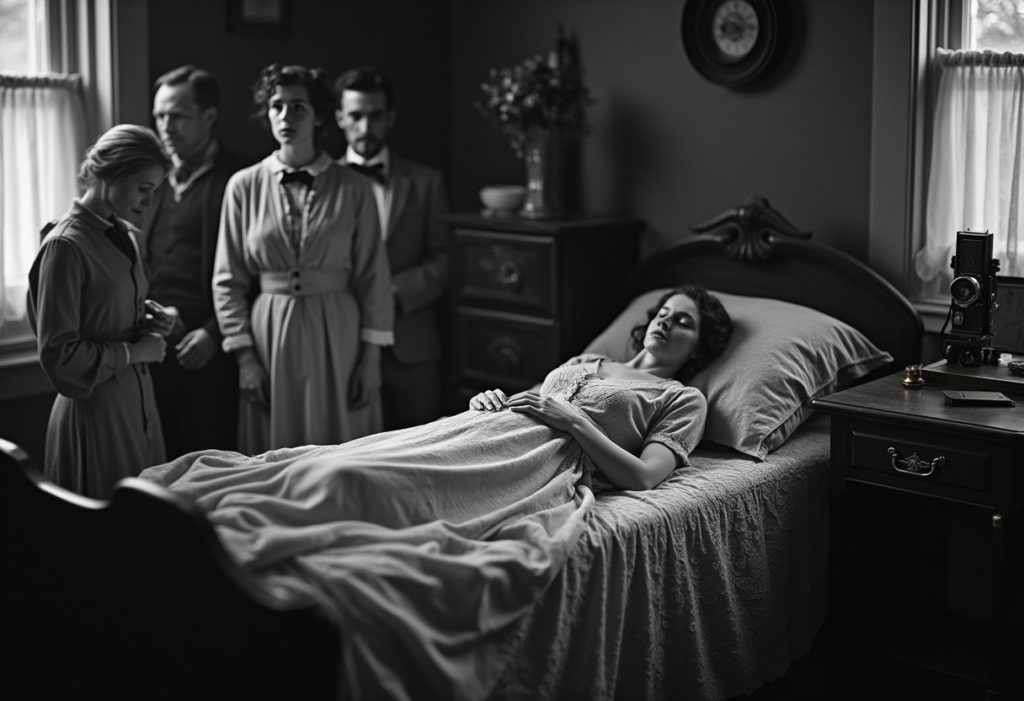
In this intricate dance between technological innovation and societal need, the daguerreotype was only the beginning. As new photographic methods emerged, such as the ambrotype and tintype, post-mortem photography likewise evolved. These advancements made the process faster and less cumbersome, allowing photographers greater freedom to experiment with composition and presentation. The ambrotype, for instance, offered a more durable and visually pleasing alternative to the daguerreotype by using glass rather than metal plates. This evolution underscored an increasing democratization of memorial images, making them accessible to a broader swath of society.
Despite the growing accessibility, a post-mortem photograph was never a casual endeavor. It required skill and sensitivity to execute properly, bearing a weight of expectation from grieving families. Photographers often received detailed instructions on how the deceased should be posed and what personal effects should accompany them in the frame. Small details—like a favorite book, a cherished toy, or a beloved pet—provided layers of meaning and connection. The resulting images spoke not only of loss but of the life that had preceded it, encapsulating a person’s essence within that final stillness.
The photographers themselves were often more than mere documentarians. They were quiet observers of grief, boundary-crossing artisans who imbued their work with both technical mastery and a profound sense of empathy. John Edwin Mayall, a pioneer in the field, often spoke of his mission to capture ‘the sublime beauty of eternal rest,’ a philosophy that guided his every shutter click. Similarly, William and Frederick Langenheim balanced their commercial practice with a heartfelt dedication to memorializing the deceased in a manner that families found comforting and respectful.
Across the Atlantic, American practitioners such as Charles H. Williamson also embraced this solemn art form, yet regional and cultural nuances added distinct flavors to their work. With the Civil War’s grim backdrop, the urgency of capturing soldiers before they departed for battle—and frequently after their tragic demise—cast a unique light on the American experience with post-mortem photography. Williamson, known for his poignant battlefield images, often worked under harrowing conditions, bringing a stark reality to the concept of the ‘good death,’ which was highly valued in both Northern and Southern states.
As techniques became more sophisticated, so did the staging of these portraits. Dead children were often posed as though peacefully asleep, sometimes even with their eyes painted open post-photograph to give the illusion of life. Adults were frequently depicted in repose on beds or seated, surrounded by family members in their mourning attire. Such arrangements aimed to preserve dignity and serenity, creating a comforting image meant to aid in the grieving process. These photographs served as a means of moving forward, offering solace and a physical representation of an eternally cherished memory.
The public perception of post-mortem photography was a blend of necessity and reverence, an accepted part of life’s final chapter. Victorian society, with its intricate mourning customs, viewed these images not through a lens of morbid curiosity but as sacred keepsakes, threads of continuity amidst the rupture of loss. This deeply ingrained tradition ensured that, for a time, the custom of the post-mortem photograph remained an undisputed fixture in the cultural landscape, echoing through parlors and photo albums with a silent, enduring eloquence.
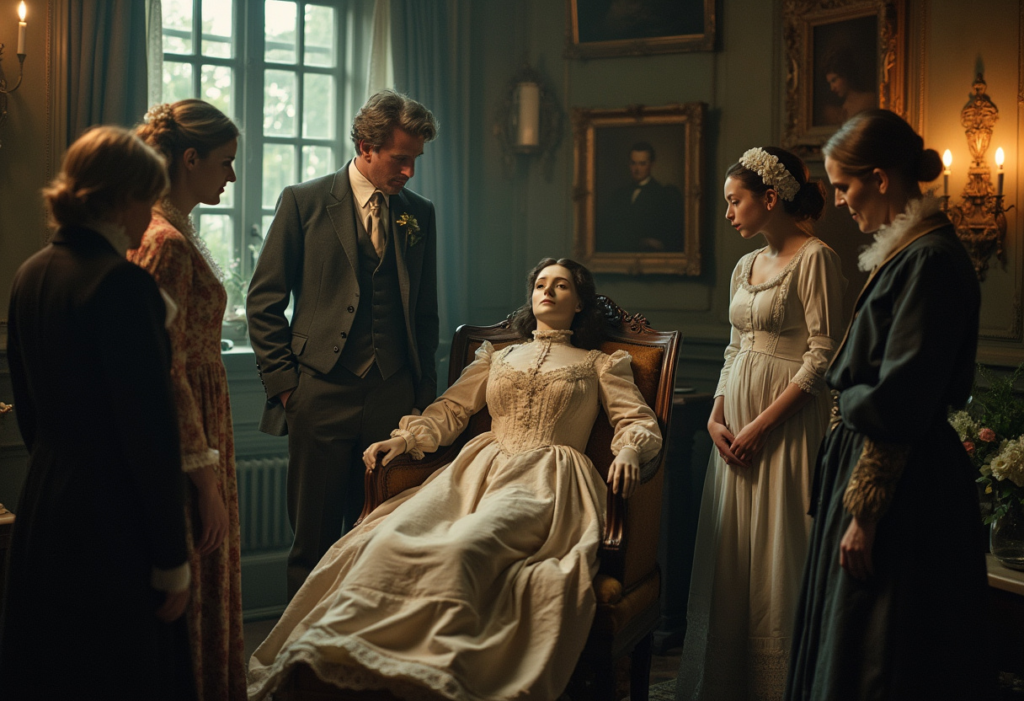
As the practice of post-mortem photography grew, it began to intertwine with broader societal shifts and technological innovations. The latter half of the 19th century saw rapid advancements in photographic equipment and techniques, further embedding the medium into the fabric of everyday life. Camera technology transitioned from the laborious and delicate daguerreotype to the more versatile ambrotype and tintype, each iteration improving accessibility and realism. This continual evolution allowed post-mortem photographers to expand their creative horizons, capturing the deceased in ways that brought out the nuances of their personalities—in life and in death.
Yet, the journey was not without its challenges. The act of capturing the dead required not only technical prowess but a keen sensitivity to the emotions of grieving families. Photographers assumed the roles of both artists and empathetic facilitators, guiding families through the painful yet cathartic process of immortalizing their loved ones. Often, the photographer would need to work swiftly, as decomposition could set in quickly, adding a layer of urgency to an already delicate task. This time sensitivity necessitated a high degree of skill and precision, ensuring the final image preserved dignity and respect.
One prevalent technique involved propping the deceased in lifelike poses, sometimes supported by stands or hidden braces, lending an illusion of vitality. For children, this often meant arranging them as though peacefully napping, with toys or favorite items close at hand. Adults might be depicted reclined, surrounded by mourning family members, their expressions a blend of sadness and solemnity. Such images served to blur the boundary between life and death, creating a visual narrative of tranquility and eternal rest that brought comfort to the bereaved.
The intimate nature of post-mortem photography often led to enduring relationships between photographers and their clients. Many families returned to the same studios for multiple generations, each visit adding another layer to their visual legacy. This continuity reinforced the photographer’s role not merely as a service provider but as a custodian of family history. Through these enduring connections, post-mortem photographers became silent witnesses to the ebb and flow of life, their work forming a tangible bridge across generations.
Economic factors also played a significant role in the accessibility of post-mortem photography. While initially a service reserved for the affluent, technological advancements and mass production gradually democratized the process. By the late 19th century, even modest households could afford to have a post-mortem photograph taken, a testament to the practice’s deep-seated cultural importance. The proliferation of photographic studios ensured that more families could partake in this poignant tradition, preserving the visage of their loved ones for future generations.
The cultural significance of post-mortem photography in Victorian society cannot be overstated. It represented a confluence of technological achievement, artistic endeavor, and societal need, creating a lasting testament to an era preoccupied with both life and loss. As the practice evolved and spread, it carried with it a silent yet powerful dialogue about mortality and memory. By capturing the final image of the deceased, post-mortem photographers provided a unique form of solace and continuity, embedding their art into the very essence of how societies remember and honor their dead.
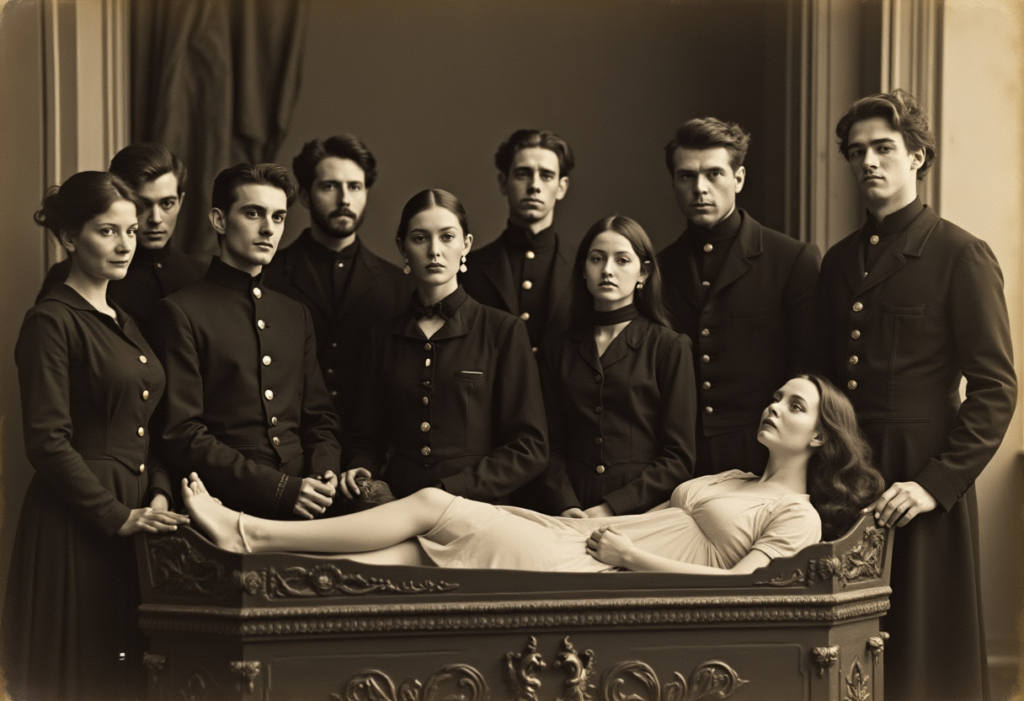
Post-mortem photography, or ‘memento mori’ as it was often called, was more than a mere photographic practice; it was deeply embedded in the cultural and societal norms of the time. Across various continents, the way death was perceived and commemorated differed significantly, and these variations profoundly impacted post-mortem imagery. Each photograph not only preserved the likeness of the deceased but also encapsulated cultural rituals and attitudes toward death, serving as a window into the values and beliefs of diverse societies. The melting pot of traditions created a rich tapestry of post-mortem photography, each unique in its symbolism and execution.
In Europe, particularly during the Victorian era, post-mortem photography was an extension of elaborate mourning customs. Mourning attire, black crepe armbands, and the meticulous staging of the deceased in photographs all mirrored the cultural need to publicly display grief. The images from this period often featured the deceased surrounded by their living relatives, creating a poignant juxtaposition that highlighted the continuity of family despite the rupture of loss. These somber portraits acted as a bridge between the living and the departed, reinforcing familial bonds and offering a form of emotional solace.
On the other side of the Atlantic, the practice evolved similarly but adapted to the nuances of American cultural contexts. The aftermath of the Civil War saw an explosion in the demand for post-mortem photography as families sought to memorialize their fallen soldiers. These images, often captured in rugged outdoor settings or makeshift studios near battlefields, bore a rawness and immediacy that contrasted with the more formal European style. Yet, they served the same fundamental purpose: to provide a tangible connection to those lost amidst the turmoil.
Moving further afield, in Latin America, post-mortem photography adopted distinct characteristics influenced by indigenous and colonial histories. Practices such as the ‘Day of the Dead’ highlighted a complex relationship with mortality, viewing death as a continuation rather than an end. Photographs from this region frequently included vibrant elements and symbols of both life and death, reflecting a cultural celebration of the deceased’s transition to the afterlife. This blend of reverence and festivity offered a unique lens through which to view the practice.
In Asia, post-mortem photography also found its place within varied cultural traditions. In Japan, for instance, the Meiji era’s embrace of Western technologies led to the adoption of photography, including post-mortem portraits. These images often adhered to the Japanese aesthetic principles of simplicity and tranquility, capturing the deceased in serene, contemplative poses. They became cherished family relics, often integrated into household altars and ancestral worship practices, underscoring the deep respect for forebears.
Across these diverse cultures, one unifying theme emerges: the role of post-mortem photography as a tool for mourning and memory. The photographs transcended their initial purpose, becoming integral parts of family heritage. They not only documented loss but also celebrated the life and legacy of the deceased, offering a lasting tribute that could be passed down through generations. The intimate, often affectionate, nature of these images provided families with a means to process grief, preserve memories, and honor their loved ones.
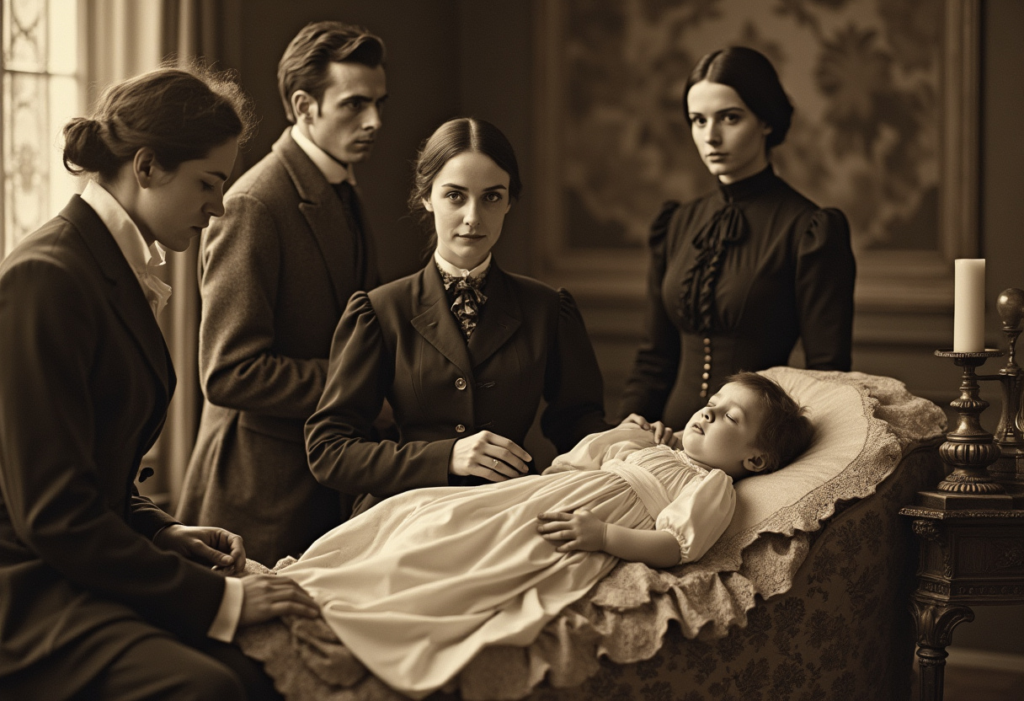
The intricate rituals associated with death often found expression through the lens of a camera, serving both as a memorial and a vital cultural artifact. In Victorian England, mourning traditions were highly regimented, involving prescribed attire and behaviors that outwardly signified inner grief. Post-mortem photographs integrated seamlessly into these customs. The bereaved dressed the deceased in their finest clothes, sometimes even adorning them with jewelry or other personal effects, before posing them for one last portrait. This meticulous attention to detail ensured that the photograph would serve as a dignified and loving remembrance, a visual eulogy in an era obsessed with propriety and decorum.
In America, the practice reflected a melting pot of cultural influences and regional variations. The Civil War had left indelible scars on the national psyche, and post-mortem photography became a poignant means of honoring those who perished. Soldiers were often photographed in their uniforms, sometimes alongside their weapons or other symbols of their service, creating a powerful testament to their valor and sacrifice. These images bridged the gap between the battlefield and the homefront, providing grieving families with a tangible connection to the loved ones they had lost to the ravages of war.
Across continents, each culture imbued its post-mortem photographs with unique symbols and meanings. In Mexico, the Day of the Dead celebrations infused the imagery with a vibrant, almost celebratory quality. Photographs often depicted the deceased with marigold flowers, sugar skulls, and other festive elements, juxtaposing the somber reality of death with the exuberant colors of life. This duality reflected the cultural view of death as a continuation of life’s journey rather than an abrupt termination, a belief that found profound expression through these cherished photographs.
Similarly, in Japan, ancestral veneration influenced the depiction of the deceased. Photographs from the Meiji era captured individuals in tranquil poses, often surrounded by elements of nature, emphasizing a seamless transition to the spiritual realm. These images were not merely keepsakes but integral parts of household altars, serving as a bridge between the living and their ancestors. The serenity and simplicity of these portraits echoed the broader cultural respect for harmony and continuity, reinforcing the enduring bond between generations.
In Africa, post-mortem photography intersected with rich oral traditions and communal mourning practices. These photographs often captured not just the deceased but the surrounding families and entire communities participating in elaborate funerary rites. Such images documented more than familial grief; they recorded the collective memory of the community, preserving the rituals and symbols that defined their approach to death. The visual record became a shared repository of cultural identity, reinforcing communal bonds even as it commemorated individual lives.
In each of these cultural contexts, post-mortem photography served to navigate the complex landscape of grief, memory, and identity. The photographs functioned as a means of processing loss while simultaneously celebrating the life that had passed. They provided a physical manifestation of memory, a tangible artifact through which future generations could connect with their ancestors. As these images traveled through time, they became more than mere reflections of the past; they were enduring testimonies to the resilience of human memory and the universal quest to honor and remember our departed loved ones.
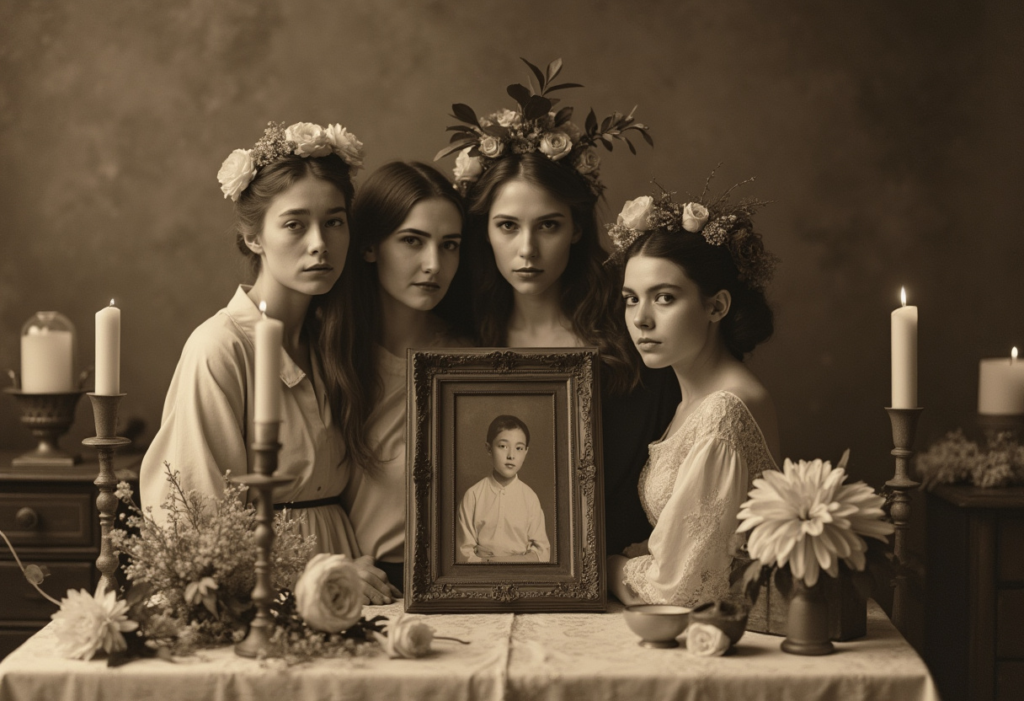
In some cultures, this practice extended beyond the immediate act of mourning and became interwoven into broader traditions of ancestral worship and veneration. In China, for instance, the reverence for ancestors was paramount, and post-mortem photography served as a modern extension of age-old practices. These photographs were often placed in family altars, forming a visual lineage that spanned generations. Through these images, descendants could maintain a tangible connection to their forebears, preserving a sense of continuity and familial pride. The photographs became sacred artifacts within these domestic shrines, embodying the enduring presence of the deceased within the family unit.
In juxtaposition, in certain Western societies, the secularization of death over time saw a shift in how post-mortem photography was perceived and utilized. Initially, these images were deeply entwined with religious and spiritual beliefs surrounding death and the afterlife. Families desired that the final image encapsulated not just the essence of their loved one but also their transition to a higher plane of existence. However, as secular views became more prominent, the focus shifted towards capturing a dignified remembrance, devoid of overt religious connotations. The photographs evolved into cherished family heirlooms, valued more for their emotional connection than their spiritual symbolism.
Another interesting cultural adaptation is observed in Eastern Europe, where post-mortem photography intersected with local superstitions and folkloric beliefs. In some regions, it was believed that capturing the image of the deceased could safeguard their soul, preventing it from wandering restlessly. These photographs often featured symbolic elements meant to protect the spirit, such as crosses, rosaries, or other religious artefacts. The delicate interplay between folk traditions and Christian iconography gave these images a distinctive character, blending reverence with pragmatic concerns about the afterlife.
In Australia, indigenous communities adopted post-mortem photography in ways that reflected their unique relationship with the land and their ancestors. Particularly in the late 19th and early 20th centuries, these images were not merely portraits but visual narratives that encompassed the person’s life and connection to their environment. The deceased were often depicted in natural settings or accompanied by elements significant to their identity and community. These photographs became a vital part of oral history traditions, offering a visual complement to the stories passed down through generations, and reinforcing the continuity of cultural heritage.
Meanwhile, in parts of Southeast Asia, the blending of local animistic beliefs with Buddhist practices influenced how post-mortem photography was approached. The serene depictions of the deceased often reflected a peaceful continuation into the next life, a concept deeply rooted in Buddhist teachings. The use of natural elements, such as flowers and serene landscapes, within the photographs symbolized the transitory nature of life and the harmonious cycle of existence. These images became more than mementos; they were visual representations of philosophical beliefs, intertwining the spiritual with the temporal.
Concluding this exploration, it is clear that post-mortem photography was far more than a transient fad; it was a profound expression of humanity’s enduring need to remember and honor the dead across varied cultural landscapes. Each image, imbued with the customs and beliefs of its time, provides a poignant window into the ways humans grapple with loss and seek connection with their loved ones. As these photographs pass through generations, they transcend their original purpose, becoming timeless artifacts of cultural heritage and personal memory. Through the lens of post-mortem photography, we witness the universality of grief and the myriad ways societies find solace and continuity in the face of death.
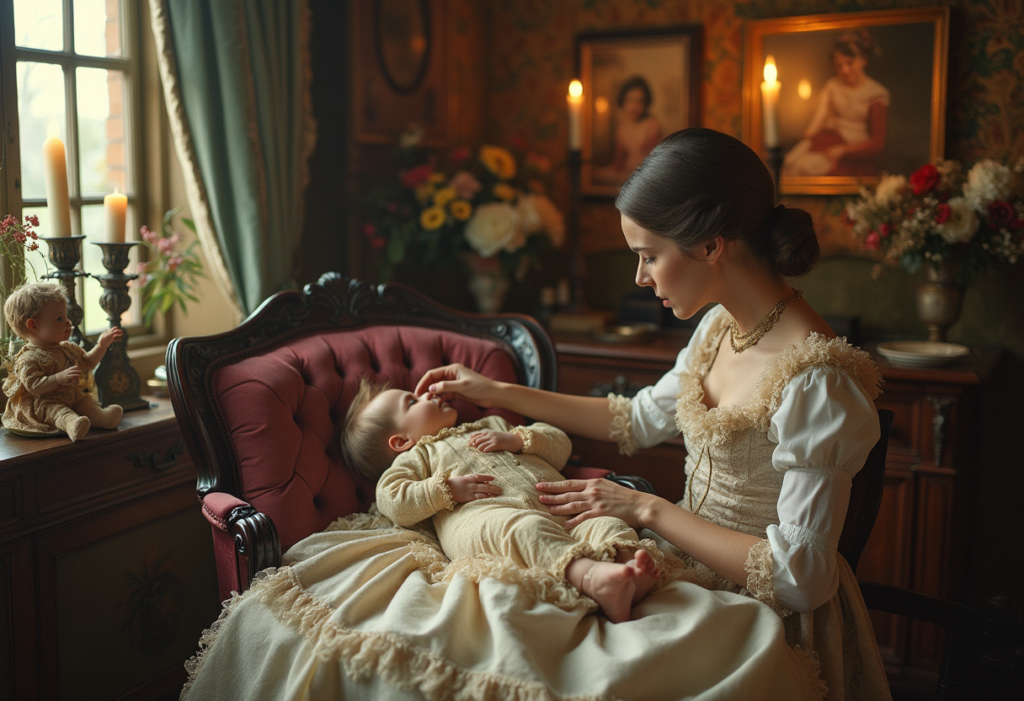
Among the shadows of Victorian portrait studios, artisan photographers navigated a world laden with both technical challenge and profound emotional intensity. These practitioners, often unsung, played pivotal roles in helping families immortalize their deceased loved ones. Their craft required an intricate blend of technical mastery, artistic sensitivity, and an unyielding sense of empathy. Post-mortem photography was more than a mere service; it was an intimate rite of passage, facilitated by these artisans who stood at the intersection of memory and mourning.
John Edwin Mayall, a name now interwoven with the early days of post-mortem imagery, approached his work with a philosophy that sought the ‘sublime beauty of eternal rest.’ Mayall’s portraits were characterized by their serene composition and meticulous attention to detail. Employing soft lighting and delicate props, he captured the deceased in poses that conveyed peace and dignity. His studio, a quiet sanctuary amidst the bustling streets of London, became a haven where grief found a silent, visual expression.
In America, Charles H. Williamson’s work stood out amid the tumultuous backdrop of the Civil War. Travelling across battlefields, Williamson’s images were raw and immediate, encapsulating the stark reality of loss faced by countless families. His portraits, often depicting fallen soldiers with their regimental insignia, were more than mere records; they were poignant tributes that bridged the chasm between life and death. The urgency and severity of his task imbued his work with an authenticity that deeply resonated with those who mourned their lost kin.
Photographers like Mayall and Williamson faced significant ethical dilemmas in their work. The delicate balance between artistic intention and respectful representation required a profound understanding of both technical and emotional nuances. The weight of their responsibility was immense, for these final images carried the emotional weight of the families’ farewells. It was this understanding that informed their approach, ensuring each photograph was both a respectful homage and a beautiful piece of artistry.
One of the greatest challenges in post-mortem photography lay in capturing the essence of life within the stillness of death. Techniques were continually refined to create lifelike appearances; some photographers employed subtle methods, like painting open eyes on closed lids, to evoke a sense of presence. The use of personal belongings in the frame—beloved toys, favorite books—added layers of narrative, turning each photograph into an intimate story of a life once led.
As these artisans developed their craft, they often formed deeply personal relationships with their clients. The families who walked through their doors entrusted them with their most precious memories, fostering a bond between photographer and subject that transcended the mere transaction of services. This connection was immortalized in each portrait, a silent testament to love and loss. The mastery and empathy of these early photographers not only preserved the visage of the departed but also offered solace to those left behind, etching the final chapter of a life into the annals of family history.
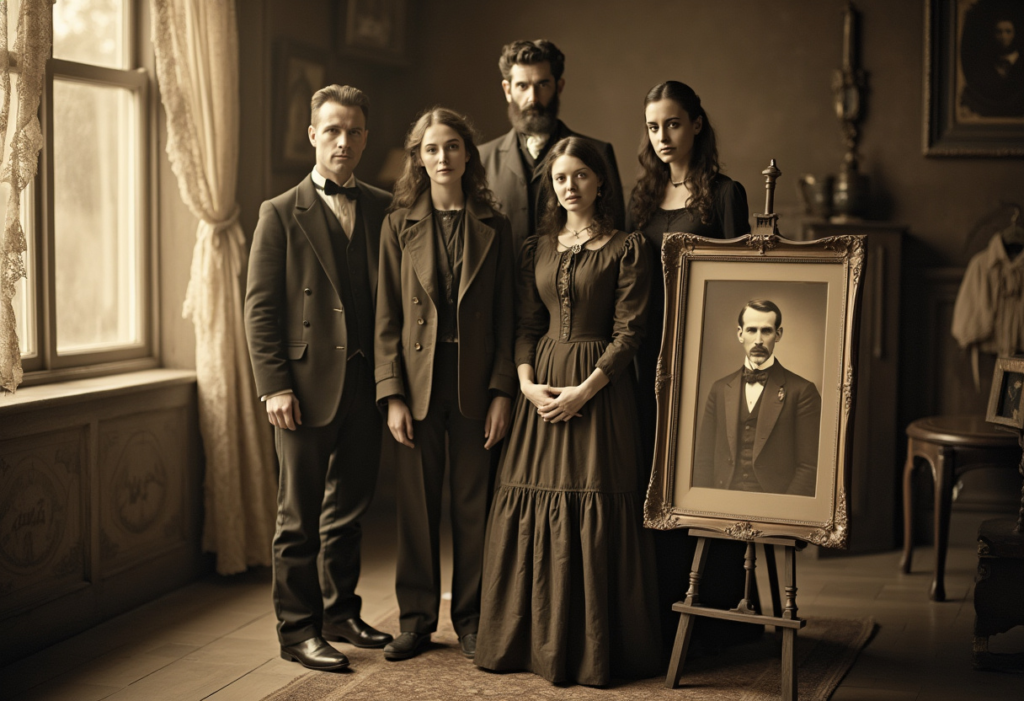
Beyond the lenses and the darkrooms, post-mortem photographers navigated the profound emotional landscapes of their clientele, often finding themselves drawn into the deepest corners of sorrow and memory. Charles H. Williamson, for instance, was not just a photographer but a documentarian of grief. His battlefield compositions were stark and devoid of pretense, capturing not only the fallen soldiers but also the collective mourning that echoed through the war-torn nation. Williamson’s work transcended the mere act of recording faces; it immortalized moments of collective loss, creating a visual chronicle of an era steeped in battle and sacrifice.
In a quiet contrast, the European counterpart, particularly in Victorian England, displayed a different kind of intimacy. Photographers like Mayall, with his soft lighting and carefully chosen props, created an almost ethereal serenity. Families entrusted Mayall with more than just a final portrait; they handed over shards of their broken hearts, seeking comfort and a semblance of continuity in his art. His studio became a haven, where life’s transience was gently coaxed into permanence, each image a tender yet poignant reflection of love’s last look.
The technique used to balance the line between life and death was an art in itself. Photographers would often use hidden supports or paint on glass negatives to open eyes, giving the deceased an appearance of peaceful repose. This technique, while bordering on eerie for modern sensibilities, was a reflection of the profound desire to capture the essence of the individual, as though they were caught in a moment of serene slumber. The artistry lay not in deception, but in the gentle preservation of dignity, a visual balm to soothe grieving hearts.
Ethical considerations were a constant companion in this delicate craft. Each click of the shutter carried with it a weight of responsibility, ensuring that the image was a respectful homage rather than a macabre spectacle. The photographers had to tread carefully, balancing the artistic with the reverential, creating portraits that were as much about love as they were about loss. Their aptitude for empathy was as crucial as their technical skills, often serving as the bridge between the bereaved and their final farewell.
Personal philosophies of these artisans varied, yet they shared a common thread of respect for their subjects and the families they served. Fredrick Langenheim, for example, approached each session with a profound sense of duty. To him, every photograph was a sacred trust, an unspoken promise to honor the memory of the deceased through the lens of his camera. This commitment reflected a universal truth among these photographers: their work was more than a vocation; it was a calling, imbued with reverence and compassion.
These post-mortem images, while specific to their cultural contexts, share a universal language of sorrow, remembrance, and love. As the artisans wove their technical prowess with heart-felt empathy, they created poignant legacies that bridged the chasm between the past and the present. Their contributions transcended mere documentation, becoming timeless tributes that continue to resonate with the quiet dignity and profound emotion with which they were created.
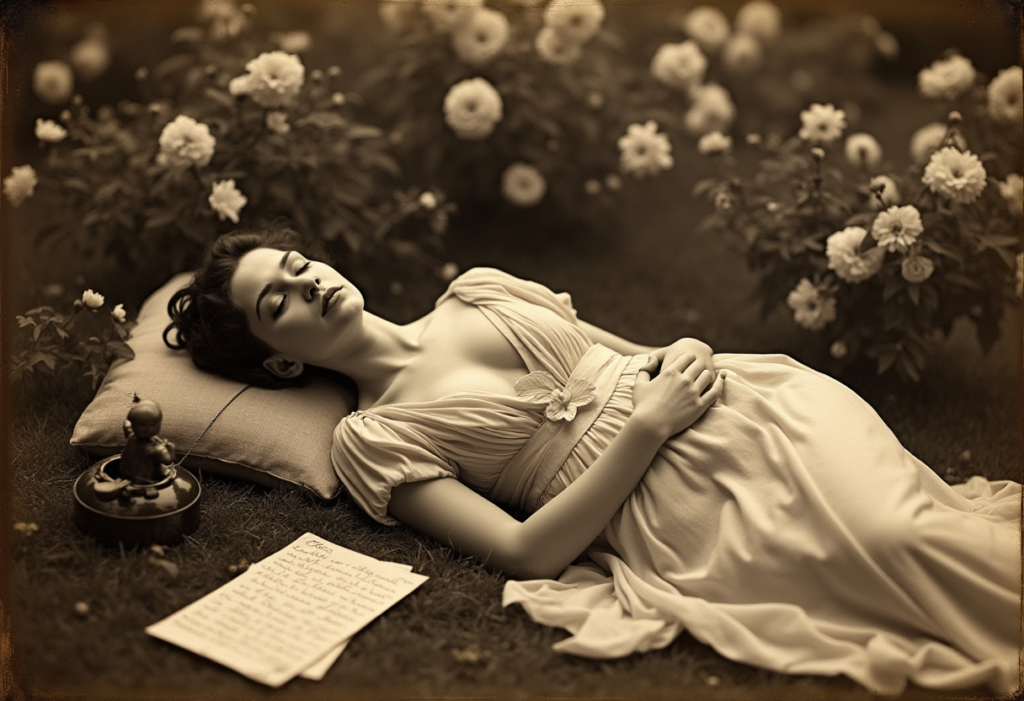
Among these artisans, E.C. Branson stands out for his innovative approach and the solemn humanity that suffused his work. Known for his evocative use of light and shadow, Branson could transform a mundane setting into a poignant tableau. His subjects, often posed with personal artifacts like family heirlooms or cherished letters, exuded a silent narrative that went beyond mere portrayal. Branson viewed each photograph as a ‘visual elegy,’ where every detail, down to the curve of a hand or the angle of a head, was meticulously considered to convey both peace and lingering essence.
In France, Eugène De Lions carved a unique niche, blending his classical training with an intuitive grasp of the emotional landscape surrounding post-mortem photography. De Lions often incorporated elements of nature, arranging the deceased in lush garden settings or amidst elegantly draped curtains, suggesting a gentle passage into another realm. His work exuded a quiet nobility, turning the final image into a serene, almost otherworldly experience that comforted families while honoring the individuality of their loved ones.
In the American Midwest, Matilda J. Frame brought a maternal touch to her practice. Known for her empathy and gentleness, Frame was often called upon to photograph children. Her studio became a sanctuary for grieving parents, a space where Frame’s compassionate eye captured the tenderest of depictions. She would often cradle the departed child in blankets or arrange favorite toys around them, evoking a serene slumber. Her work provided a source of solace and healing, transforming the unbearable weight of loss into a gentle farewell.
Each photographer developed their unique methodologies to navigate the technical and emotional intricacies of this art form. They experimented with various compositions, lighting techniques, and props to cast the deceased in the most dignified light possible. Their ability to blend technical mastery with emotional sensitivity ensured that each photograph was more than a mere record of a final moment; it was an enduring testament to lives interwoven with love and memory.
Challenges abounded, not least the technical constraints of the era. Photographers contended with lengthy exposure times and the precarious nature of early photographic materials. This necessitated a blend of patience and precision, capturing images under challenging conditions without compromising the integrity or dignity of the moment. The artisans’ ability to work efficiently while maintaining the emotional resonance of their subjects’ final portraits underscored their profound skill and dedication.
The ethical considerations these artisans faced were not trivial. They had to strike a delicate balance, ensuring their work was respectful and artistically valid without crossing into exploitative territory. Their success lay in their ability to approach each session with genuine empathy, creating images that served as both a final act of love and a poignant echo of life’s tender frailty. In their hands, the last photograph became a bridge, spanning the gap between the physical absence of a loved one and the continuity of their memory.
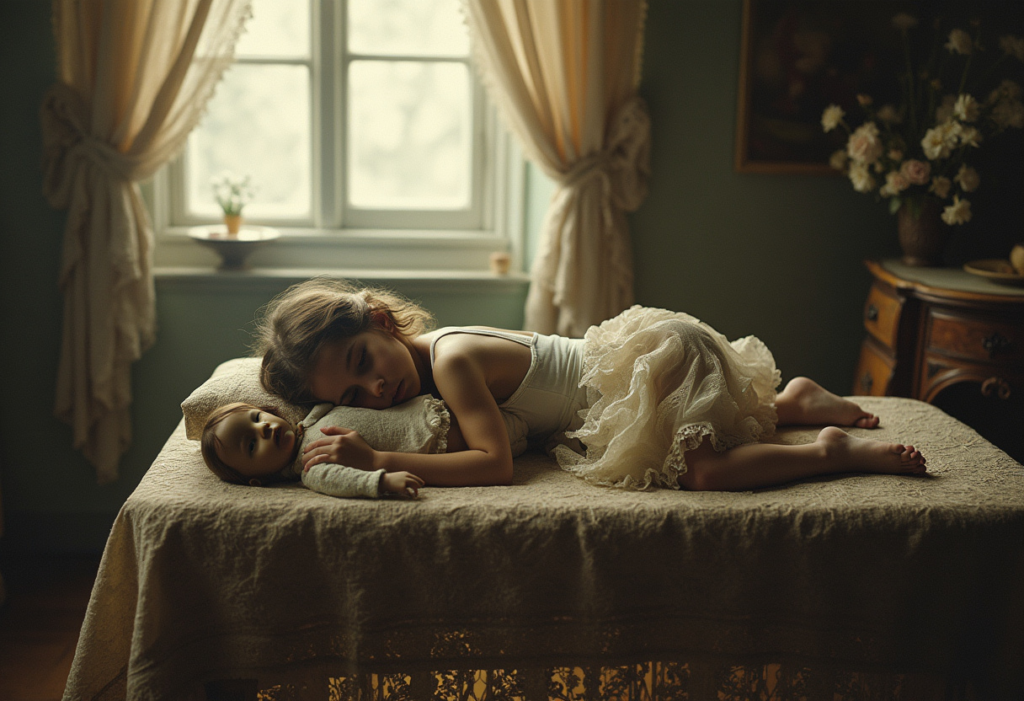
The fragile silence of grief often finds its most eloquent expression through the stillness of a photograph. Among the myriad tales etched into the fibers of post-mortem portraits, the story of young Clara Wynne emerges with a tender poignancy. Clara, a child of seven whose life was truncated by a sudden bout of scarlet fever, was captured in her final repose by photographer Matilda J. Frame. The image, replete with Clara’s favorite doll nestled beside her, comforted her parents in their profound sorrow, offering a visual thread to a life abruptly halted.
Clara’s mother later wrote in her diary about the solace she found in this bittersweet memento, a testament to the photograph’s enduring impact on memory and mourning. Clara’s portrait, a tender depiction of innocence lost, became a cherished relic within the Wynne household, a symbol of love and remembrance that bridged the chasm of her absence. Each glance at the image prompted a cascade of memories, preserving Clara’s presence in a tangible form.
The Wynnes’ diary entries reveal the deep interweaving of grief with gratitude for Frame’s gentle and empathetic approach. Through the lens, Frame had not merely captured an image but had crystallized an ephemeral embrace that resonated through the years, offering comfort amidst the relentless ache of loss.
In another corner of history, we encounter the solemn narrative of Captain William Holmes. His life, dedicated to service and abruptly cut short in the throes of a Civil War skirmish, was commemorated through a post-mortem photograph taken by Charles H. Williamson. Williamson’s frame, stark yet reverent, depicted Holmes in his full regalia, his face serene amidst the surrounding turmoil. This portrait became a beacon for his family, a piece of visual solace that stood steadfast against the merciless tide of time.
The Holmes family, grappling with the void left by William’s passing, found an aching yet profound comfort in the photograph. Letters exchanged among family members reflect their gratitude towards Williamson’s artistry, which transformed their shared grief into a visual testament of William’s valor and sacrifice. The photo became an heirloom, a familial touchstone that kept William’s spirit and story alive within their collective memory.
The intimacy of post-mortem photography often mirrored the private dialogues it preserved. The tale of Emma and Thomas White illustrates this with an arresting clarity. Emma, overcome by consumption, spent her last moments with her husband by her side. Thomas’s request for John Edwin Mayall to capture Emma’s serene departure was an act of love and remembrance. The resulting image, framed against the delicate lace of Emma’s wedding dress, testified to a love that transcended life’s brevity.
Thomas’s diary entries reveal his struggle yet solace found in the photograph, a frozen whisper of his beloved Emma. For Thomas, the portrait of Emma was not merely a depiction of her final repose but a visual anchor amidst the storm of his grief. Mayall’s delicate composition, enshrined within the frame, offered Thomas a beacon of serene continuity. The photograph became a sacred object within his daily life, an ever-present reminder of Emma’s kindness and their shared journey. Through the lens, Emma’s essence permeated the fibers of memory, easing Thomas’s solitary reflection with the warmth of her undying presence.
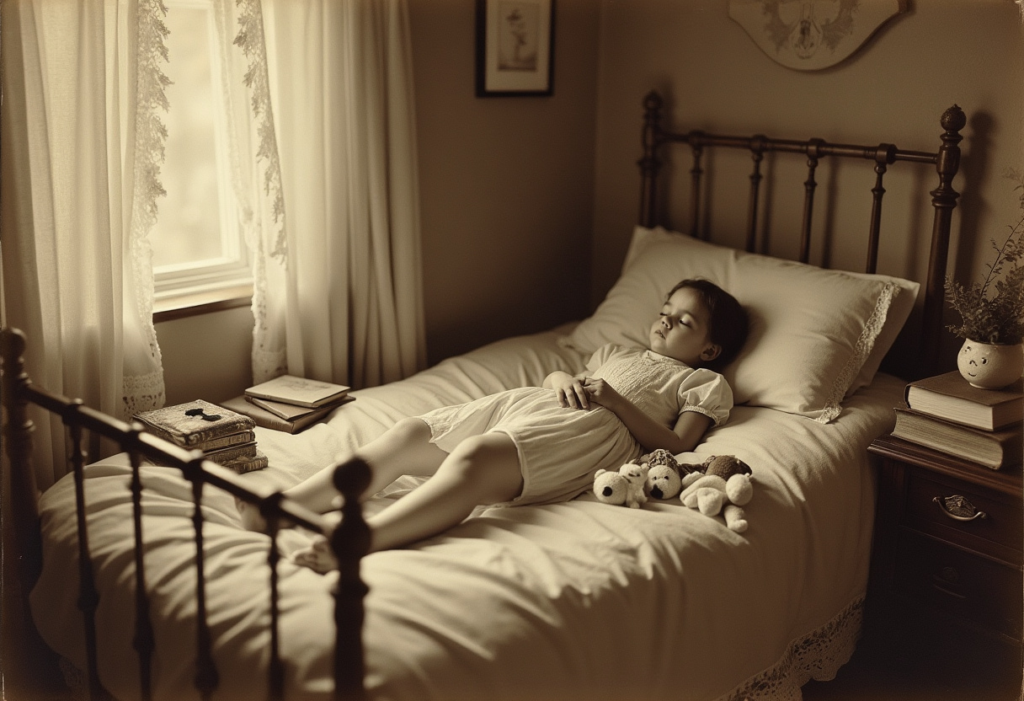
Within the recesses of post-mortem photography is the tender narrative of little Michael Reilly, a boy whose brief life was extinguished by diphtheria. The Reilly family, grappling with the sudden loss, turned to the renowned photographer, Fredrick Langenheim, for a final portrait. Langenheim, known for his empathetic approach, positioned Michael amongst his cherished toys, imbuing the scene with a sense of peaceful innocence. For the Reillys, this photograph became more than a remembrance; it served as a manifestation of Michael’s spirit, a beacon of his joy amidst their sorrow. The family often spoke of how the photograph invited them to celebrate Michael’s life rather than succumb to the abyss of loss.
In yet another poignant vignette, Matilda J. Frame captured the solemn beauty of Anne-Marie Lafleur, who succumbed to tuberculosis in her early twenties. The Lafleur family, steeped in a deep sense of loss, sought Frame’s gentle artistry to memorialize their beloved daughter. Frame’s photograph, bathed in soft natural light, depicted Anne-Marie as though peacefully asleep, her beloved books arranged thoughtfully around her. The resulting image carried a weight of serenity, offering the Lafleurs a visual touchstone that honored Anne-Marie’s love for literature and life. Her mother often contemplated this image during long winter evenings, drawing strength and solace from the luminous portrayal.
Across the vast landscape of grief, another story is stitched through the lens of Eugène De Lions, an artisan whose keen eye brought solace to many. The case of Eliza Grout, a Parisian seamstress who passed away quietly in her sleep, stands out in particular. De Lions, with his characteristic blend of natural elements, arranged Eliza amongst delicate fabrics and lace, echoing her life’s work and passions. Each fold and shadow in the photograph spoke of Eliza’s artistry, forging an enduring connection for her family. The Grouts found in this photograph a means to celebrate Eliza’s legacy, her spirit intertwined with the tactile memories of her craft.
Lesser-known but equally impactful is the image of George Whitmore, a blacksmith from a small English village whose life was claimed by a sudden accident. John Edwin Mayall, summoned by Whitmore’s family, crafted an image that immortalized George in his work attire, hammer in hand, surrounded by the tools of his trade. This portrayal transcended mere remembrance, capturing the essence of George’s labor and dedication. The community rallied around this image, displayed prominently in the village square to serve as both a tribute and a communal memory. Local letters and anecdotes reveal how the photograph helped knit the community’s collective grief into a fabric of shared remembrance and respect.
Amid the myriad stories, one encounters the poignant tale of Eleanor Brown, captured by the meticulous lens of E.C. Branson. Eleanor, having succumbed to pneumonia, was immortalized against the backdrop of her beloved garden. Branson’s photograph, playing with light and shadow, conveyed a sense of continuity with nature. The Browns cherished this image, which occupied a place of honor in their home. Over time, it became a silent witness to their family’s resilience, a reminder of Eleanor’s nurturing spirit.
The art of post-mortem photography, in its vivid intimacy, stretches beyond a simple photograph; it is a conduit through which families anchor their grief and find solace. The artisans behind these images, with their unparalleled sensitivity and skill, provided more than a lens to the past. They crafted enduring testaments to love, memory, and the human spirit, ensuring that those captured within their frames were forever remembered with dignity and grace. Thus, the photographs not only chronicled lives but immortalized the bonds that death could not sever, offering solace and a tangible connection to those who once walked among us.

Among these poignant chronicles is the tale of Jonathan Reed, a humble cobbler whose pristine craft was abruptly ended by an unexpected accident in his workshop. His grieving widow, yearning for a tangible connection to her lost partner, commissioned renowned photographer Eugène De Lions for a final portrait. De Lions delicately posed Jonathan amid his tools, his hands arranged as though mid-task. This thoughtful composition brought a semblance of life to the inert form, transforming the photograph into a poignant celebration of Jonathan’s dedication and skill. For Mrs. Reed, this image was a source of daily solace, a silent partner in her solitude that encapsulated the essence of her husband’s devotion both to his work and to her.
The gentle narrative of Margaret O’Hara reveals another layer of intimacy in post-mortem photography. Taken by Matilda J. Frame, Margaret’s portrait captures her in the tranquility of sleep, her hands clasping her favorite rosary. These delicate details were orchestrated with profound reverence by Frame, who understood the significance of the rosary to Margaret’s Irish Catholic faith. For the O’Hara family, this photograph became a sacred object, imbued with spiritual as well as emotional solace. Letters from Margaret’s eldest son reflect the comfort he found in this image, often meditating on the serene expression of his mother’s face, which seemed to whisper peace even in silence.
In the heart-wrenching account of Samuel Blakely, a young coal miner lost to a sudden collapse, the artistry of Fredrick Langenheim skillfully navigated the intersection of grief and dignity. Langenheim composed Samuel’s portrait with a miner’s lamp and helmet, symbols of a life characterized by hard toil and humble valor. When Samuel’s family received this photograph, it wasn’t merely the image of a body they saw; it was a tribute to a life cut short by the very labor that sustained them. This photograph, displayed in their modest home, became a beacon of Samuel’s sacrifice, a silent nod to his enduring spirit amidst the soot and struggle of their daily lives.
E.C. Branson’s evocative portrayal of Eliza Sternemann, a decorated nurse who succumbed to a virulent illness while attending war casualties, offers another glimpse into the emotional landscape of post-mortem photography. Branson’s arrangement, which included Eliza’s nursing cap and medals, highlighted her sacrifice and fortitude. The Sternemann family, proud yet heartbroken, found in this portrait a dual purpose: it honored Eliza’s service and immortalized her compassion. Diary entries from Eliza’s sister reveal the deep pride and comfort this image provided, encapsulating Eliza’s dedication and serving as a visual testament to her unyielding spirit.
The stirring story of Clara Bolton, immortalized by John Edwin Mayall, touches on the profound bond of mother and child. Clara, laid to rest cradling her infant daughter who also perished due to the same illness, was tenderly captured by Mayall in an embrace of eternal repose. This photograph was a testament to Clara’s nurturing love, depicting a serene unity in death. Clara’s husband, grappling with the dual loss, found in this image a poignant reminder of their shared life, a visual narrative of grief that also conveyed enduring love and connection.
As these intimate stories attest, the legacy of post-mortem photography extends far beyond its immediate purpose. Each photograph served as a vessel of memory, enabling families to navigate the tumultuous tides of loss with a tangible reminder of their loved ones’ presence. The artisans behind the lens provided more than a mere service; they offered a bridge between life and death, transforming ephemeral moments into enduring legacies that continue to resonate through the annals of family history. Through each carefully crafted image, they wove the threads of memory and love, ensuring that the departed remained a cherished part of the living world, their essence immortalized in the quiet stillness of a photograph.
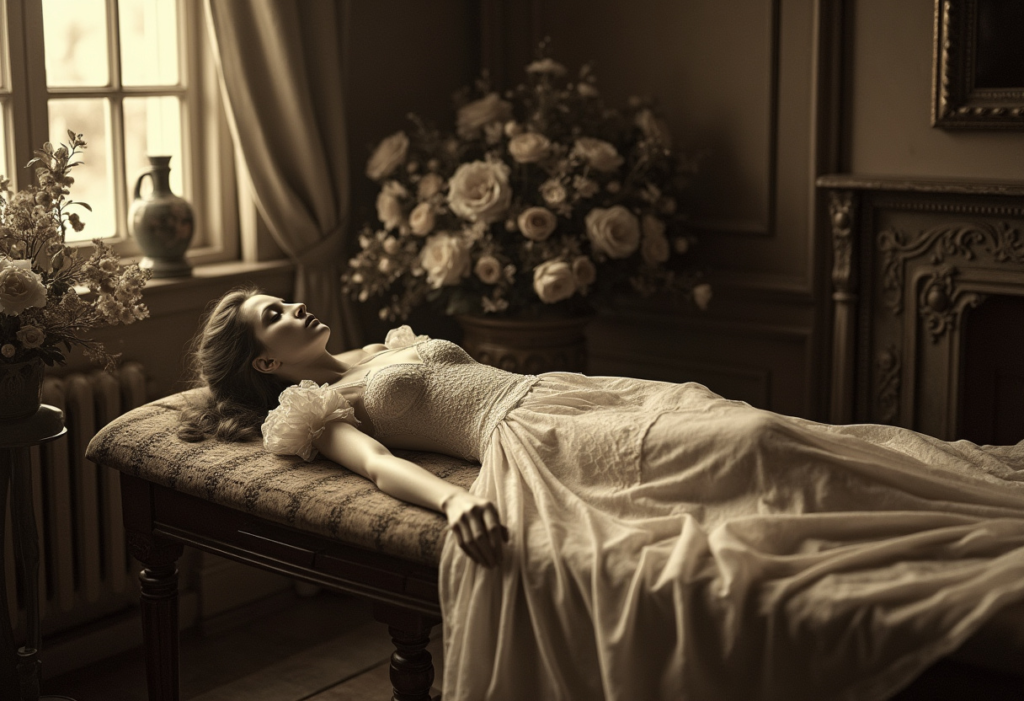
As the 20th century unfurled, the practice of post-mortem photography experienced a gradual decline, mirroring shifting societal attitudes towards death and the deceased. Medical advancements drastically reduced the mortality rates from what were once common afflictions, thereby decreasing the frequency of untimely deaths that had necessitated such poignant keepsakes. The rise of modern medicine brought with it a new sense of longevity, altering the public’s relationship with the inevitability of death.
Where Victorian society had been deeply intertwined with the rituals of mourning, the new century leaned towards a more sanitized and distant approach to end-of-life matters. Moreover, the evolution of funeral practices played a significant role in this shift. The advent of professional funeral homes began to replace the intimate, family-centered rituals of the past. These institutions offered an array of services that distanced the bereaved from the immediate realities of death. Embalming became a standard procedure, perpetuating an image of serene stillness that negated the need for photographic preservation. With these changes, the role of post-mortem photography as a memorializing tool dwindled, relegated to a relic of an earlier era.
Advancements in photographic technology also contributed to its decline. The increasing casualness and accessibility of everyday photography diminished the special status that post-mortem images once held. Families no longer relied on a single formal portrait to remember their deceased loved ones; instead, numerous photographs captured throughout life provided ample visual records. The unique poignancy of a post-mortem photograph lost its resonance amidst the flood of images that now chronicled life’s every turn. Culturally, the face of mourning began to change, influenced by a society growing more reluctant to confront the stark realities of death. By the mid-20th century, images of the dead were often considered unsettling, taboos forming around the open display of death in domestic spaces. The aesthetic of mourning shifted towards the sublimated, with more focus on the celebration of life than the depiction of death. Post-mortem photography, once an accepted means of honoring a memory, became a practice shrouded in discomfort and reluctance.
Yet, even as its prevalence waned, post-mortem photography never completely disappeared. In contemporary times, it found new life within the realms of art and media, where its historical and emotional gravitas offered profound subject matter. Photographers and artists began to revisit and reinterpret these images, exploring themes of mortality, memory, and the passage of time. Post-mortem photographs became windows into a bygone era, their stark beauty and haunting solemnity resonating with new audiences who sought to understand their cultural heritage.
The lasting legacy of this practice is evident in its enduring influence on modern depictions of death. Contemporary media and art continue to draw inspiration from the aesthetic and emotional depths of post-mortem photography. These images serve as powerful reminders of a time when death was an integral, visible part of life, connecting us to the human experiences of grief and remembrance. This ongoing dialogue between past and present ensures that these poignant portraits maintain their relevance, perpetuating the tender narratives they encapsulate as timeless artifacts of love, loss, and memory.
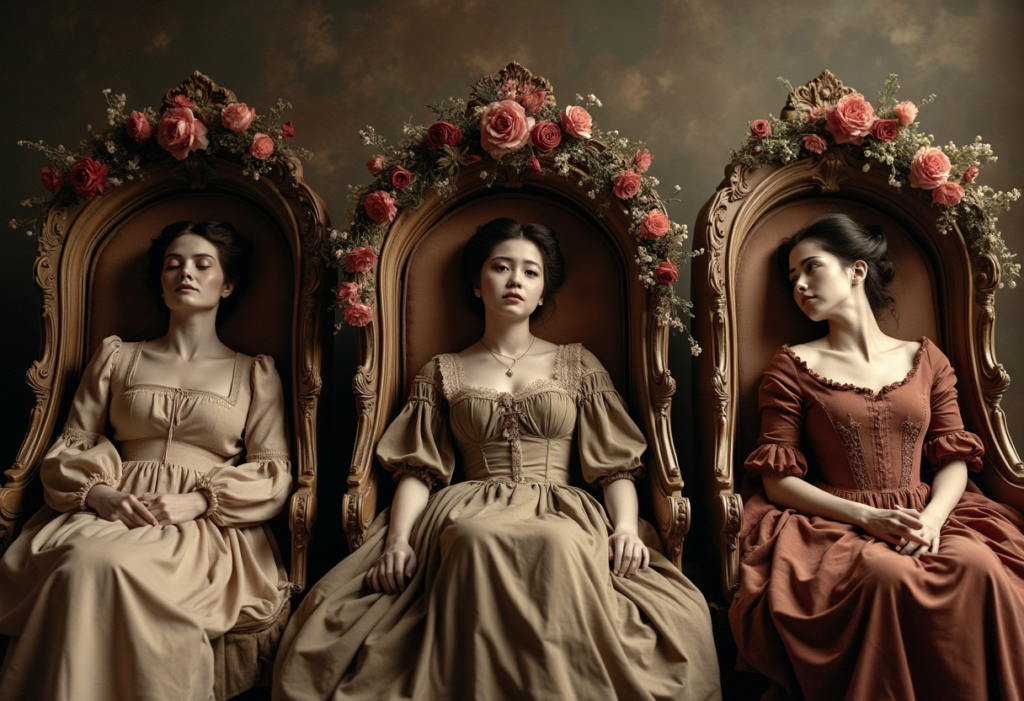
The decline of post-mortem photography marked a significant shift in cultural attitudes towards death, reflecting broader social transformations of the 20th century. As medical breakthroughs extended life expectancy, society became increasingly distanced from the ubiquity of death. The intimate rituals of mourning that had once necessitated these poignant images were replaced by more clinical, impersonal customs. Death moved from the parlor room to the hospital and funeral home, becoming a sanitized process that often occurred out of sight. This detachment reshaped the collective approach to memorialization, making the once-common practice of post-mortem photography appear antiquated and macabre.
Professional funeral homes further contributed to this transformation by offering comprehensive services that included embalming, cosmetic restoration, and memorial printing. These institutions provided a controlled environment where the deceased could be viewed in a state of serene repose, lessening the perceived need for post-mortem photographs as lasting keepsakes. Families came to rely on these establishments to manage the logistics and aesthetics of death, distancing themselves from the visceral, hands-on engagements that had been a hallmark of 19th-century mourning practices.
The rapid proliferation of personal photography also played a crucial role. By the mid-20th century, the advent of affordable, portable cameras enabled families to amass extensive visual chronicles during their loved ones’ lifetimes. These living photographs, brimming with vitality, gradually overshadowed the somber post-mortem images that had once served as primary memorials. The proliferation of vibrant snapshots celebrated life’s moments rather than memorializing its cessation, reflecting a cultural pivot towards embracing the joyful aspects of existence.
This cultural pivot found expression in shifting artistic and societal norms. Once a public and accessible practice, the display of post-mortem photographs became increasingly private, sometimes secretive, as societal discomfort with death grew. The aesthetic of remembrance shifted towards floral wreaths and celebratory gatherings, fostering environments where death was acknowledged but not dwelled upon. The Victorian ideal of immortalizing rest gave way to more subtle expressions of mourning, integrated into less conspicuous aspects of daily life.
Yet, the cultural significance of these portraits endured, finding resurgence and reinterpretation in contemporary art and media. Artists and historians began to view post-mortem photographs as rich historical documents teeming with emotional and cultural significance. Exhibitions and retrospectives brought these images to new audiences, emphasizing their role in the collective human experience of loss and remembrance. The stark beauty and raw emotion captured in these portraits resonated with modern viewers, prompting reflections on mortality in an era increasingly distanced from death.
The endurance of these images speaks to their timeless nature, serving as poignant reminders of an era when death was a visible, integral part of life. Post-mortem photographs continue to haunt the collective memory, their silent eloquence challenging the prevailing aversion to confronting mortality. As relics of a bygone era, they invite us to explore how societies have navigated the delicate balance between life and death, memory and loss, offering a window into the enduring quest to immortalize the essence of those who have passed.
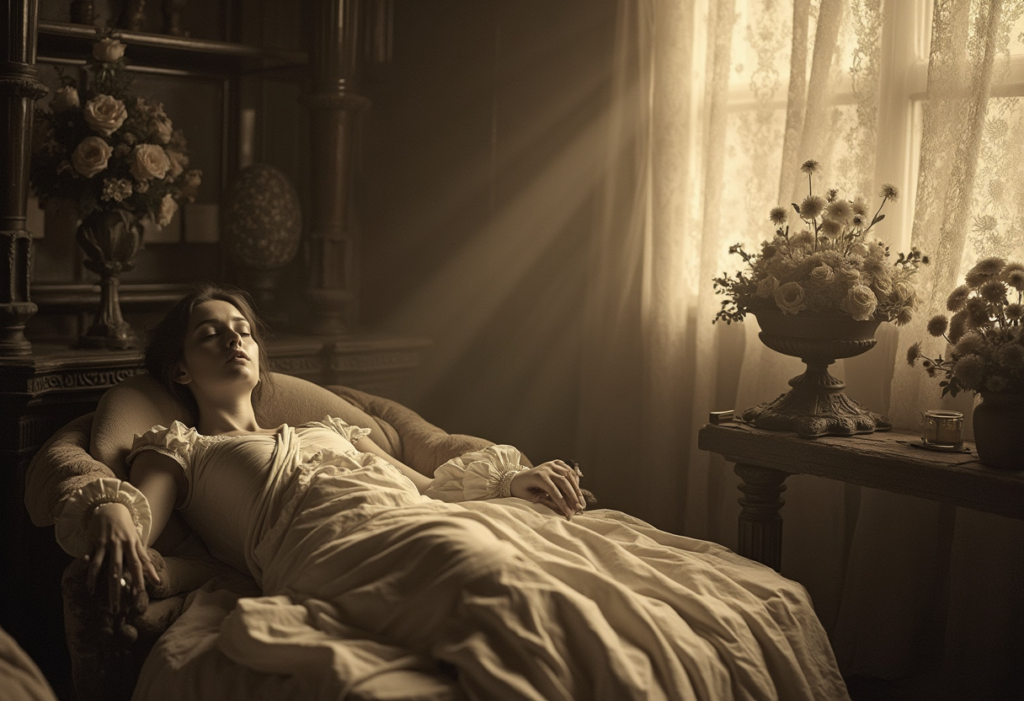
As society advanced through the 20th century, the once prevalent tradition of post-mortem photography receded into the annals of history. The convergence of medical advancements, which drastically reduced the frequency of untimely deaths, and the rise of professional funeral services reshaped how death was perceived and commemorated. The intimate realities of loss, once captured in the lingering stillness of a photograph, gave way to a more sanitized, distant approach to mourning. This shift reflected a broader cultural reluctance to engage with the stark finality of death, favoring instead the subtler, more celebratory expressions of life’s fleeting nature.
The advent of accessible, casual photography further diluted the practice’s necessity. Families, now able to amass extensive collections of photos throughout loved ones’ lives, no longer relied solely on a single post-mortem portrait for remembrance. These living photographs, vibrant with momentary joys and everyday occurrences, overshadowed the somber, frozen images that once bore the weight of final goodbyes. This evolution in visual culture marked a significant departure from the richly symbolic and emotionally laden tradition of post-mortem photography.
Despite its decline, the silent eloquence of these portraits retained a haunting relevance. Rediscovered by historians and artists, post-mortem photographs became potent symbols within contemporary explorations of mortality and memory. Art exhibitions and academic studies shed new light on the cultural and emotional dimensions of these images, framing them not as macabre relics but as profound expressions of love and loss. This reinterpretation connected modern audiences with the poignant narratives embedded within each photograph, fostering a renewed appreciation for their historical and emotional significance.
In the realm of contemporary art, the legacy of post-mortem photography manifests as a compelling dialogue between past and present. Artists draw inspiration from the genre’s aesthetic and thematic depths, creating works that challenge contemporary attitudes towards death and remembrance. These modern iterations resonate deeply, evoking the timeless human need to honor and remember the departed. Through this lens, post-mortem photography transcends its historical context, becoming a medium through which the complexities of grief and memory are continually explored and redefined.
The enduring influence of post-mortem photography also pervades media and popular culture. Films, literature, and visual arts frequently nod to the genre, utilizing its stark imagery to evoke the profound emotional undertones associated with life’s fragility. This resurgence underscores a collective yearning to reconnect with the raw, unfiltered expressions of mourning that characterized earlier times. By revisiting and reinterpreting these photographs, contemporary society engages in a broader conversation about the ways we confront and cope with the reality of death.
As we turn the final pages on this exploration, it becomes clear that post-mortem photography, though largely a relic of a bygone era, continues to cast a long shadow over our cultural consciousness. These images, etched with the delicate interplay of life and death, serve as timeless artifacts that bridge the chasm between generations. They remind us of a period when death was an intimate, visible part of life’s tapestry, and through their quiet presence, they offer a profound testament to humanity’s enduring quest to honor, love, and remember.

